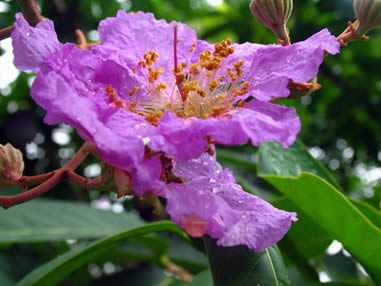 Banaba (Lagerstroemia speciosa) is a species of Lagerstroemia native to tropical southern Asia. The tree is called the Crape Myrtle. The leaves of the Banaba and other sections are used often by the, Taiwan, and Philippines as a tea preparation. In isolated cells, corosolic acid, is known to stimulate glucose uptake. In vitro experiments show that banaba extracts demonstrated a similar activity to insulin in causing glucose update by cells. In addition, banaba leaf includes a elevated concentration of antioxidant compounds for protecting against oxidative stress and indicates anti inflammatory effect.
Banaba (Lagerstroemia speciosa) is a species of Lagerstroemia native to tropical southern Asia. The tree is called the Crape Myrtle. The leaves of the Banaba and other sections are used often by the, Taiwan, and Philippines as a tea preparation. In isolated cells, corosolic acid, is known to stimulate glucose uptake. In vitro experiments show that banaba extracts demonstrated a similar activity to insulin in causing glucose update by cells. In addition, banaba leaf includes a elevated concentration of antioxidant compounds for protecting against oxidative stress and indicates anti inflammatory effect.
Banaba Benefits
Banaba have been used for long years in traditional medicine to treat diabetes, with the first published research study being reported in 1940. The banaba extracts include corosolic acid, a component being studied for its insulin like effect of lowering the glucose in the body. The active insulin-like triterpenoid component, corosolic acid, has been shown to stimulate glucose into cells andis effective in reducing blood glucose and insulin levels. (On the other hand, unlike insulin, banaba extract has been found to be effective when taken orally). Other important properties in banaba extract contain the phytochemicals lager-stroemin, flosin B and reginin A, which could also play a role in the blood glucose level reduction.
Researches performed by Dr. Yamazaki, have shown that the banaba includes corosolic acid, which has insulin-like effects. Studies performed by Dr. William V. Judy, confirmed that corosolic acid lowers the blood sugar levels. In a study reported in “Bioscience, Biotechnology, and Biochemistry” in 1996, researchers showed that treating diabetic mice with banaba extract (diet containing 5% of the hot-water extraction from banaba leaves) helped protect against high blood sugar levels. The antidiabetic effect of an extract from the leaves of banaba standardized to 1% corosolic acid (glucosol preparation) has been showed in a randomized study involving Type II diabetics. Glucosol at daily doses of 32 and 48 mg for two weeks demonstrated a important decrease in the blood glucose levels. Blood sugar levels, were 20 % less with powder capsules, and 30 % less with a softgel extract. (July 2003 edition the Journal of Ethnopharmacology).
Dosage
It is usually administered in daily doses of 8-48 milligrams, with a 1-2% concentration of corosolic acid. High doses should be avoided due to the likely for hypoglycemia.
Leave a Reply